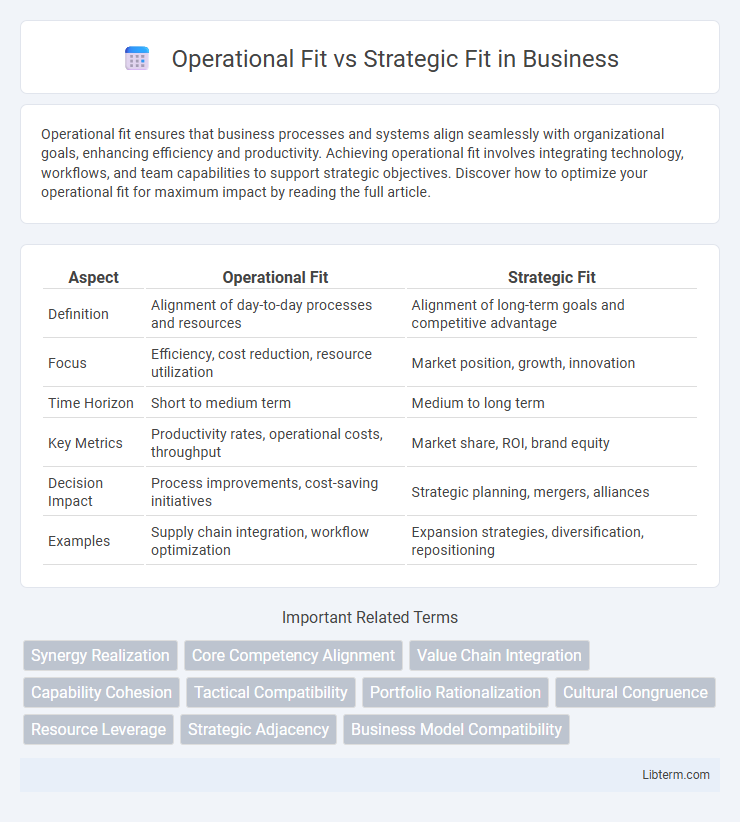Operational fit ensures that business processes and systems align seamlessly with organizational goals, enhancing efficiency and productivity. Achieving operational fit involves integrating technology, workflows, and team capabilities to support strategic objectives. Discover how to optimize your operational fit for maximum impact by reading the full article.
Table of Comparison
| Aspect | Operational Fit | Strategic Fit |
|---|---|---|
| Definition | Alignment of day-to-day processes and resources | Alignment of long-term goals and competitive advantage |
| Focus | Efficiency, cost reduction, resource utilization | Market position, growth, innovation |
| Time Horizon | Short to medium term | Medium to long term |
| Key Metrics | Productivity rates, operational costs, throughput | Market share, ROI, brand equity |
| Decision Impact | Process improvements, cost-saving initiatives | Strategic planning, mergers, alliances |
| Examples | Supply chain integration, workflow optimization | Expansion strategies, diversification, repositioning |
Understanding Operational Fit: Key Concepts
Operational fit refers to the compatibility of day-to-day processes, systems, and resources between organizations, ensuring seamless integration and efficient collaboration. Key concepts include alignment of workflows, technology compatibility, and operational efficiency that enable smooth execution of combined activities. Prioritizing operational fit supports minimizing disruptions, reducing costs, and enhancing overall performance post-integration.
Defining Strategic Fit in Business Context
Strategic fit in a business context refers to the alignment between a company's long-term goals, market positioning, and core competencies with the external environment and competitive landscape. It emphasizes how well resources, capabilities, and business activities support overarching strategic objectives to create sustainable competitive advantage. Achieving strategic fit ensures coherence between internal strengths and external opportunities, driving effective strategic decision-making and growth.
Differences Between Operational and Strategic Fit
Operational fit focuses on the alignment of day-to-day activities and processes within an organization, ensuring efficient use of resources and smooth workflow. Strategic fit involves the congruence between a company's long-term goals and its external environment, emphasizing competitive positioning and market opportunities. Differences between operational and strategic fit lie in their scope and timeframe, with operational fit addressing immediate performance and strategic fit guiding overarching business direction and sustainability.
Importance of Aligning Operations with Strategy
Aligning operations with strategy ensures that organizational resources are utilized efficiently to achieve long-term business objectives. Operational fit translates strategic goals into actionable processes, driving consistent performance and competitive advantage. Misalignment between operations and strategy can lead to wasted resources, operational inefficiencies, and failure to meet market demands.
Assessing Operational Fit: Tools and Methods
Assessing operational fit involves analyzing the compatibility of resources, processes, and capabilities between organizations using tools such as SWOT analysis, GAP analysis, and process mapping. Key methods include performance metrics evaluation, benchmarking, and scenario planning to identify operational synergies and integration challenges. Effective operational fit assessment ensures alignment in supply chain management, technology infrastructure, and organizational culture to optimize merger or partnership success.
Evaluating Strategic Fit: Frameworks and Criteria
Evaluating strategic fit involves analyzing how well a potential business partnership aligns with long-term corporate goals, using frameworks like SWOT analysis and the McKinsey 7S model to assess compatibility across strategy, structure, and shared values. Criteria include market position synergy, resource complementarity, and cultural alignment to ensure sustainable competitive advantage. Strategic fit emphasizes adaptability and vision coherence, guiding decision-makers in prioritizing partnerships that foster growth and innovation.
Common Challenges in Achieving Fit
Operational fit and strategic fit often face common challenges such as misaligned organizational goals, conflicting resource allocation, and inconsistent communication between departments. These issues hinder the integration of daily operational activities with long-term strategic objectives, resulting in decreased efficiency and reduced competitive advantage. Addressing these challenges requires a clear alignment framework and continuous performance monitoring to ensure cohesive execution across all levels.
Impact of Poor Fit on Organizational Performance
Poor operational fit leads to inefficiencies and resource misallocation, directly decreasing productivity and increasing costs. Lack of strategic fit results in misaligned goals and missed market opportunities, undermining long-term competitive advantage. Organizations experiencing poor fit endure reduced employee morale, fragmented processes, and weakened financial performance.
Case Studies: Operational vs Strategic Fit in Action
Case studies reveal that operational fit prioritizes the seamless integration of systems and processes to enhance efficiency, as seen in manufacturing mergers that streamline supply chains. In contrast, strategic fit focuses on aligning long-term goals and market positioning, exemplified by acquisitions aiming to enter new markets or innovate product lines. Companies combining both approaches, such as technology firms merging to leverage operational synergies while pursuing strategic growth, often achieve sustainable competitive advantages.
Best Practices for Achieving Both Fits
Achieving operational and strategic fit requires aligning day-to-day processes with long-term business goals through continuous performance measurement and agile resource allocation. Best practices emphasize cross-functional collaboration to integrate operational efficiencies with strategic initiatives, ensuring adaptability and scalability. Leveraging advanced data analytics and real-time feedback systems optimizes decision-making and drives sustained competitive advantage.
Operational Fit Infographic

 libterm.com
libterm.com